Moving Urban Sculptures towards Sustainability: The Urban Sculpture Planning System in China
Abstract
:1. Introduction
2. Materials and Methods
3. Situating Urban Sculptures within Chinese Cultural Policies and Urban Planning Systems
- Lack of systematic coordination. Due to the market-oriented urban sculpture construction, the overall distribution of urban sculptures in many cities is uneven. Most artists usually work in their own independent fields without consideration of the relationships between these sculptures and other existing ones [59]. In particular, the lack of an overall arrangement for characteristics and themes of urban sculptures results in a singleness of form and the duplication of subject matter within the proposed site vicinity. This will not only lead to a waste of urban resources, gentrification of certain areas, and increasing disparities, but it can also be detrimental to the principles of equity balance. In addition to the fairness of the urban sculpture layout, urban sculptures should be given priority in areas in which they are relatively scarce [60].
- Loss of cultural identity. Affected by cultural globalization, China has also been influenced by Western art. There are too many similar sculptures emulated from the West, making it impossible to construct a unique urban cultural landscape [61,62]. The sculptures are mass-produced by factories as industrial products without cultural meaning, formal sense, or taste in art [63]. The mass production of these urban sculptures aggravates the phenomenon of “thousands of cities with one appearance (qian cheng yi mian)”. There is a lack of understanding of regional culture, especially in works responding to regional culture [64].
- Reduction of life cycle. The life span of urban sculptures includes both their physical life and artistic life [65]. Lack of research on sculptural materials and production techniques results in their reduction in the physical life span. Materials should withstand climatic conditions, such as sun, heat, and freezing as well as winter salt exposure. There is no corresponding policy to strengthen the protection of existing urban sculptures, so professional maintenance and repairs cannot be carried out [59]. What is more important is the abnormal shortening of the urban sculptures’ art life, which is demonstrated by their disharmony with the surrounding environment. An inconsistency of characteristics, such as theme, site selection, and material, could result in relocation or dismantling only a short period after the sculpture was constructed [66]. These processes cause a waste of construction funds, manpower, and resources [65]. For Chinese cities, the urban space holding sculptures may change due to rapid urbanization. For example, the statue of Sun Yat-sen in Nanjing was moved due to the construction of the subway and the upgrading of the transportation system. The reason for this was a disjunction between the superior planning of the urban spatial development and the construction of urban sculptures, which cannot meet the long-term and short-term goals of urban development.
- Non-standard management system. Urban sculpture construction is based mainly on local management and lacks overall city coordination. The management levels of different districts are uneven and the division of responsibilities are not clear, as they lack unified mechanisms throughout the entire process of production. Many cities do not have a specific department to manage the construction of sculptures. Therefore, the construction of sculptures cannot be combined with several major projects in urban transformation, such as the regeneration of historical and cultural blocks. Contrary to the principle of intergenerational equilibrium, the spontaneous construction of sculptures in the short-term will lead to overdevelopment. Construction should satisfy the long-, medium-, and short-term goals, and be carried out in a planned and regulated manner [67]. In some cities, urban sculptures are often monopolized by a small number of governors and elites, meaning that the citizens cannot participate in the process, which goes against the principle of people-orientation [68,69].
4. Drafting Strategies for Urban Sculpture Planning from the Perspective of Sustainability
4.1. Structure and Image
4.2. Identity and Heritage
4.3. Space and Function
4.4. Coordination and Management
5. Discussions and Conclusions
Author Contributions
Funding
Acknowledgments
Conflicts of Interest
Appendix A
| City | Year | Document Type and Title | Other Issues |
| Beijing | 1988 | (a) Beijing Urban Sculpture Construction Planning Outline | |
| 2003 | (a) Beijing Urban Sculpture Construction Development Plan(2004–2014) | ||
| 2008 | (a) Interim Regulations on Urban Planning and Construction in Beijing | ||
| 2009 | (b) Beijing City Center Urban Sculpture Planning | 1. Beijing urban sculpture construction planning principles; 2. Beijing urban sculpture theme; 3. Beijing urban sculpture layout; 4. Urban sculpture quality; 5. Urban sculpture planning and construction implementation measures; 6. Beijing urban sculpture planning project; including character statues, historical events, group sculpture, urban historical and cultural signs, national art sculpture park | |
| Shanghai | 1996 | (a)Shanghai Municipal Sculpture Construction Management Measures | |
| 2004 | (b)Shanghai Urban Sculpture Master Plan (2004–2020) | ||
| Shenzhen | 1994/2004/2017 | (a)Shenzhen Special Economic Zone Urban Sculpture Management Regulations | |
| 2002 | (a)Shenzhen Municipal Special Economic Zone Urban Sculpture Management Regulations | ||
| 1998 | (b)Urban Sculpture Planning | ||
| 1999/2012 | (b)Shenzhen Special Economic Zone Urban Sculpture Master Plan | ||
| 2002 | (b)Shenzhen City Center Sculpture Planning | ||
| Guangzhou | 2001 | (b)Guangzhou Science City Urban Sculpture Planning | |
| 2002/2015 | (b)Guangzhou City Sculpture Master Plan Revision | ||
| - | (b)Guangzhou Urban Sculpture System Planning (2015–2030) | Three types of shaft gallery, key area, node | |
| Hangzhou | 2007 | (a)Hangzhou City Sculpture Construction Management Measures | |
| 2008 | (b)Hangzhou City Sculpture Master Plan | ||
| 2011 | (b)Hangzhou City Sculpture Special Plan | ||
| Kunshan | 2016 | (b)Kunshan Urban Sculpture Planning | |
| Changsha | 2004/2015 | (b)Changsha Urban Sculpture Planning (2004–2020) | "One heart, one garden, one axis, two belts, multiple points" urban sculpture overall layout [105] Historical and cultural sculpture area |
| Wuxi | 2014 | (b)Taihu Urban Sculpture Planning | The selection of urban sculpture theme, the overall spatial layout of urban sculpture (urban gateway, major roads along the main public activity center and square, city park, scenic area, historic area, river and lakeside) |
| Mudanjiang | 2016 | (b)Mudanjiang City Sculpture Special Plan | |
| Nanning | 2005 | (a) Nanning Urban Sculpture Construction and Management Measures | |
| (b)Research on the Development Planning of Urban Sculpture in Nanning City | One belt, two rings, four axes, five gardens [82] | ||
| Xiangtan | 2010 | (b)Xiangtan City Master Plan- Sculpture Section | 1 linear layout 2 planar expansion layout 3 multi-point layout [88] |
| Wuhan | 2012 | (b)Main City Urban Sculpture and Square Planning | Vision: cultural city, city with sculptures One gallery, two belts, multiple groups [70] |
| Harbin | 2005 | (b)Harbin Urban Sculpture Planning | Two gardens, three points, four belts, five axes [79] |
| 2010 | (b)Harbin Public Art Planning | One river, one island, two belts, sixteen districts, sixteen axes, sixteen gardens, Hundreds of points [106] | |
| Xi’an | 2002 | (b)Xi’an Cityscape Sculpture System Planning | |
| 2003 | (b)Xi’an Urban Sculpture System Planning | Two axes, three rings, sixteen district [107] | |
| 2014 | (b)Xi’an Urban Sculpture Planning | Two axes, three rings, eight radiation, sixteen zones [85] | |
| 2017 | (b)Xi’an Urban Sculpture Special Plan | Sculpture demonstration Street, 12 rent public center sculpture, 16 sculpture parks and 11 rent silk road theme sculptures | |
| Suzhou | 2008 | (b)Suzhou City Sculpture Planning | One heart, two zones, two pieces [78] |
| Nanjing | 2017 | (b)Nanjing Urban Sculpture Planning | |
| Ningbo | 2011 | (b)Ningbo City Center City Sculpture Special Planning | |
| Wenzhou | 2008 | (b)Wenzhou Urban Sculpture Planning (2007–2020) | |
| Taizhou | 2004 | (b)Taizhou Urban Sculpture Planning | Six lines, one area, and multiple points. “One percent cultural policy” [62] |
| Yuyao | 2006 | (b)Yuyao Urban Sculpture Concept Planning | |
| Tianjin | 2007 | (a)Tianjin City Sculpture Management Measures | |
| 2016 | (a)Interim Provisions on the Management of Urban Sculptures for Construction Projects in Tianjin Regulations [2016] No. 213 | ||
| 2017 | (b)Tianjin Urban Sculpture Master Plan (2017–2030) | ||
| Changchun | 1996 | (b)Changchun City Master Plan (1996–2020) Sculpture Planning Section | One river, one line, two roads, two streets and parks [108] |
| 2000 | (b)Changchun Urban Sculpture Planning (2000–2020) | ||
| Qinhuangdao | 2014 | (b)Qinhuangdao Urban Sculpture Planning | |
| Huainan | 2006 | (b)Huainan Urban Sculpture Planning | Three groups, multi-center [109] |
| Tongling | 2007 | (b)Tongling City Urban Sculpture Planning (2003–2020) | Three cities, three hearts, five axes, one park, multiple nodes [107] |
| Panzhihua | 2005 | (b)Panzhihua Public Art Master Plan (2005–2020) | "T" shape structure pattern [110] |
| Mianyang | - | (b)Overall Urban Design of Mianyang City- Sculpture System Planning Section | one point, two belts, three axes, four zones |
| Luoyang | 2011 | (b)Luoyang City Sculpture System Planning (2011–2020) | Aim: Cultural sustainability [64] |
| Fuzhou | 2012 | (b)Fuzhou City Sculpture Planning | One core, two new cities, three groups, three axes [111] |
| Urumqi | 2007 | (b)Urumqi Urban Sculpture Planning (2007–2020) | |
| Shenyang | 2003 | (b)Shenyang Urban Sculpture Master Plan | |
| Chongqing | - | (b)Chongqing Main City Urban Sculpture Planning | |
| Nanyang | - | (b)Nanyang City Landscape Sculpture Planning and Design | Five windows, two rings and two axes, city square, key section [112] |
| Xianyang | - | (b)Xianyang Urban Sculpture Planning System | Multi-center, five major areas, scattered groups [107] |
References
- Li, Z. Urban Construction Practice under the Guidance of Public Art: Taking Shanghai as an Example. In Proceedings of the China Urban Planning Annual Meeting 2016, Shanghai, China, 15–20 August 2016. [Google Scholar]
- Chen, Y. Outline of City Sculpture. Sculpture 2002, S1, 14–15. [Google Scholar]
- Currier, J. Art and power in the new China: An exploration of Beijing’s 798 district and its implications for contemporary urbanism. Town Plan. Rev. 2008, 79, 237–265. [Google Scholar] [CrossRef]
- Urban Sculpture Construction Management Regulations Draft (Chengshidiaosu jiansheguanlitiaoli caoan). Association. 1985.
- Hein, H. What is public art?: Time, place, and meaning. J. Aesthet. Art Crit. 1996, 54, 1–7. [Google Scholar] [CrossRef]
- Julio, M.D.; Mitchell, W.J.T. Art and the Public Sphere; University of Chicago Press: Chicago, IL, USA; London, UK, 1992. [Google Scholar]
- Cartiere, C.; Willis, S. The Practice of Public Art; Routledge: New York, NY, USA, 2008. [Google Scholar]
- Association, A.P. The Role of the Arts and Culture in Planning Practice. 2016. Available online: https://www.planning.org/research/arts/briefingpapers/overview.htm (accessed on 1 June 2018).
- Yencken, D.; Wilkinson, D. Resetting the Compass: Australia’s Journey towards Sustainability; CSIRO: Collingwood, ON, Canada, 2000. [Google Scholar]
- Selwood, S. The Benefits of Public Art: The Polemics of Permanent Art in Public Places; Policy Studies Institute: London, UK, 1995. [Google Scholar]
- Miles, M.; Paddison, R. Introduction: The rise and rise of culture-led urban regeneration. Urban Stud. 2005, 42, 833–839. [Google Scholar] [CrossRef]
- Zukin, S. The Culture of Cities, 1st ed.; Blackwell Publishers: Cambridge, MA, USA; Oxford, UK; Melbourne, Australia, 1995. [Google Scholar]
- Landry, C. The Art of Regeneration: Urban Renewal through Cultural Activity; Comedia: Stroud, UK, 1996. [Google Scholar]
- Evans, G. Measure for measure: Evaluating the evidence of culture’s contribution to regeneration. Urban Stud. 2005, 42, 959–983. [Google Scholar] [CrossRef]
- Markusen, A.; Gadwa, A. Arts and culture in urban or regional planning: A review and research agenda. J. Plan. Educ. Res. 2010, 29, 379–391. [Google Scholar] [CrossRef]
- Márquez, B.; Fajardo, C. The impact of contemporary public sculpture on urban landscape: A project for environmental improvement and sustainability of the city of Granada. Arte y Políticas de Identidad 2014, 21, 265–278. [Google Scholar]
- Darlow, A. Cultural policy and urban sustainability: Making a missing link? Plan. Pract. Res. 1996, 11, 291–302. [Google Scholar] [CrossRef]
- Deutsche, R. Public art and its uses. In Critical Issues in Public Art: Content, Context and Controversy; Senie, H., Webster, S., Eds.; Icon Editions: New York, NY, USA, 1992; pp. 158–170. [Google Scholar]
- Joanne, S.; Venda, P.; Ronan, P. Just art for a just city: Public art and social inclusion in urban regeneration. Urban Stud. 2005, 42, 1001–1023. [Google Scholar]
- McCarthy, J. Regeneration of Cultural Quarters: Public Art for Place Image or Place Identity? J. Urban Des. 2006, 11, 243–262. [Google Scholar] [CrossRef]
- Miles, M. Interruptions: Testing the rhetoric of culturally led urban development. Urban Stud. 2005, 42, 889–911. [Google Scholar] [CrossRef]
- Du, H. Promoting construction of urban cultural landscape system by public art planning. J. South China Univ. Technol. (Soc. Sci. Ed.) 2014, 6, 94–98. [Google Scholar]
- Point, N.C. Culture and Sustainability. Available online: https://www.nordiskkulturkontakt.org/wp-content/uploads/2017/09/Culture-and-sustainability_lores.pdf (accessed on 1 June 2018).
- Soini, K.; Dessein, J. Culture-sustainability relation: Towards a conceptual framework. Sustainability 2016, 8, 167. [Google Scholar] [CrossRef]
- Hawkes, J. The Fourth Pillar of Sustainability: Culture’s Essential Role in Public Planning; Common Ground P/L: Melbourne, Australia, 2001. [Google Scholar]
- Blanc, N.; Benish, B.L. Form, Art and the Environment: Engaging in Sustainability, 1st ed.; Routledge: Abingdon, UK, 2016. [Google Scholar]
- Brundtland, G.H. Our Common Future; UN: Geneva, Switzerland, 1987. [Google Scholar]
- Bianchini, F. Cultural planning for urban sustainability. In City and Culture: Cultulral Processes and Urban Sustainability; Nystrom, L., Ed.; Swedish Urban Environment Council: Stockholm, Sweden, 1999. [Google Scholar]
- Sacha, K. Toward Global (Environ) Mental Change—Transformative Art and Cultures of Sustainability; Heinrich Böll Siftung: Berlin, Germany, 2004. [Google Scholar]
- Herman, P.; Heike, S.; Vera, D. Ecologcial Aesthetics: Art in Environmental Design: Theory and Practice; Birkhäuser Architecture: Basel, Switzerland, 2004. [Google Scholar]
- Carlson, A. Aesthetics and the Environment: The Appreciation of Nature, Art and Architecture; Routledge: London, UK; New York, NY, USA, 2007. [Google Scholar]
- David, V.; Prigann, H.; Strelow, H. Ecological Aesthetics: Art in Environmental design: Theory and Practice; Birkhäuser: Basel, Switzerland; Berlin, Germany; Boston, MA, USA, 2004. [Google Scholar]
- Zheng, H.M. On low-carbon materials in landscape sculptures. Chin. Landsc. Archit. 2011, 7, 81–84. [Google Scholar]
- Huo, M.L. Research on recycled materials in public art. Appl. Mech. Mater. 2013, 329, 71–74. [Google Scholar] [CrossRef]
- Abidin, M.Z.; Rathi, M.R.M.; Jimel, C.; Wasli, Z.; Razali, N.M. Form and meaning: Metal feline public sculpture from recyclables materials at Kuching, Sarawak. In Proceedings of the Art and Design International Conference (AnDIC 2016); Anwar, R., Mahamood, M., Md. Zain, D.H., Abd Aziz, M.K., Hassan, O.H., Abidin, S.Z., Eds.; Springer: Singapore, 2018; pp. 263–272. [Google Scholar]
- Zhang, L. Study on environment art design based on recycled materials. In Proceedings of the World Automation Congress 2012, Puerto Vallarta, Mexico, 24–28 June 2012; pp. 1–4. [Google Scholar]
- Fu, S.; Ding, K.; Liang, J. Study on ecological sustainability of sculpture. Urban. Archit. 2013, 18, 287–288. [Google Scholar]
- Kropp, W.W.; Lein, J.K. Scenario analysis for urban sustainability assessment: A spatial multicriteria decision-analysis approach. Environ. Pract. 2013, 15, 133–146. [Google Scholar] [CrossRef]
- Basiago, A.D. Economic, social, and environmental sustainability in development theory and urban planning practice. Environmentalist 1998, 19, 145–161. [Google Scholar] [CrossRef]
- Chang, T.C. Art and soul: Powerful and powerless art in Singapore. Environ. Plan. A Econ. Space 2008, 40, 1921–1943. [Google Scholar] [CrossRef]
- Miles, M. Art, Space and the City; Psychology Press: Hove, UK, 1997. [Google Scholar]
- Senie, H.; Webster, S. Critical Issues in Public Art. Content, Context, and Controversy; Smithsonian Institution Press: Washington, DC, USA, 1998. [Google Scholar]
- Martin, Z. Does cultural policy matter in public-art production? the netherlands and flanders compared, 1945–present. Environ. Plan. A Econ. Space 2011, 43, 2953–2970. [Google Scholar]
- Pollock, V.L.; Paddison, R. Embedding public art: Practice, policy and problems. J. Urban Des. 2010, 15, 335–356. [Google Scholar] [CrossRef]
- Caerdydd, C. Cardiff Public Art Strategy. 2005. Available online: https://www.cardiff.gov.uk/ENG/resident/Planning/Documents/The%20Cardiff%20Public%20Art%20Strategy.pdf (accessed on 11 November 2018).
- Culture, M.O. Urban Sculpture Construction Management Measures. 1993. Available online: http://fadu.lvshi.baidu.com/detail?searchType=statute&from=aladdin_28231&originquery=%E5%9F%8E%E5%B8%82%E9%9B%95%E5%A1%91%E5%BB%BA%E8%AE%BE%E7%AE%A1%E7%90%86%E5%8A%9E%E6%B3%95&count=20&cid=5b7d8c5a72d830c1751d047f54502bd3_law (accessed on 1 July 2018).
- BGACC. Fort Worth Public Art Master Plan Update. 2017. Available online: http://fwpublicart.org/UserFiles/PlanDraft_Vs5.pdf (accessed on 1 December 2018).
- URA. Enhancing Singapore’s City Landscape: The Public Sculptures Masterplan 2002. Available online: http://www.ura.gov.sg (accessed on 1 June 2018).
- Zheng, J. Contextualizing public art production in China: The urban sculpture planning system in Shanghai. Geoforum 2017, 82 (Suppl. C), 89–101. [Google Scholar] [CrossRef]
- Miller, T.; Yudice, G. Cultural Policy; Sage: London, UK, 2002. [Google Scholar]
- NCOCO. Reply on the Adjustment of the Management Function of Urban Sculpture Construction (Zhongyang bianban [2001] No. 150). 2001. [Google Scholar]
- Zhu, J. From urban sculpture to public art-study on the mechanism of public art construction in Beijing. Economist 2010, 5, 11–14. [Google Scholar]
- Yue, X. Theoretical and practical exploration of domestic urban sculpture planning-thoughts on urban sculpture planning. In Proceedings of the Sustainable Development Rational Planning—2017 China Urban Planning Annual Conference Proceedings (13 Landscape Environment Planning), Doguan, China, 18–20 November 2017. [Google Scholar]
- Observation and Thinking of Chinese Urban Sculpture: Public Art Needs Planning. Available online: http://cul.sohu.com/20110923/n320284630.shtml (accessed on on 30 May 2018).
- Shen, C.; Ge, Y.; Ji, F. The problems and the counter- measures in the development of the urban sculptures. City Plan. Rev. 2002, 26, 23–26. [Google Scholar]
- Young, J.; Dake, J. China’s modern public art. World Art 1997, 1, 58–59. [Google Scholar]
- Public Art: A Guide to Evaluation. 2014. Available online: http://animatingdemocracy.org/resource/public-art-guide-evaluation (accessed on 1 June 2018).
- Zhan, X.; Walker, S. Value direction: Moving crafts toward sustainability in the Yangtze river delta, China. Sustainability 2018, 10, 1252. [Google Scholar] [CrossRef]
- Zheng, F. Planning and design of sculpture spots in Jingzhou city. Jiangxi Build. Mater. 2016, 21, 36. [Google Scholar]
- Liu, X. Analysis on the planning and layout of northeast urban sculpture. Art Rev. 2016, 3, 165–168. [Google Scholar]
- Dong, Q.; Dai, X. Urban public art planning: A new field of study. J. Shenzhen Univ. 2011, 28, 147–152. [Google Scholar]
- Li, Y.; Zhang, H. A few points to note in planning of urban public art and construction management -Take the planning and construction of urban sculpture in Taizhou for example. Planners 2006, 22, 56–58. [Google Scholar]
- Jiang, Z.; Wang, H.; Tan, Q. Research on the problems of public art in urban construction in China and its measures-Taking Beijing, Shanghai and Shenzhen as examples. J. Chifeng Univ. 2015, 36, 183–185. [Google Scholar]
- Sun, W.; Yuanq, Q. Urban Sculpture Planning from the Perspective of Regional Characteristics and Culture. In Proceedings of the China Urban Planning Annual Meeting, Qingdao, China, 16–18 November 2013. [Google Scholar]
- Wang, H. National conditions and requirements of the times in the rapid development of urban sculpture planning in Chinese cities. J. Civ. Eng. Archit. Res. 2014, 1, 32–36. [Google Scholar]
- Ministry of Housing and Urban-Rural Development of the People’s Republic of China. Technical Regulations for Urban Sculpture Engineering JGJT 399-2016; China Architecture & Building Press: Beijing, China, 2017. [Google Scholar]
- Wang, H. A planning and construction research of the urban sculpture for Beijing centeral city. J. Beijing Youth Politics Coll. 2013, 22, 60–66. [Google Scholar]
- Xiong, L.; Chai, Q. Existing problems and development countermeasures of uban sculpture-Taking Ningbo city as an example. Urban Constr. Theory Res. Electron. Ed. 2013, 19, 1–5. [Google Scholar]
- Zhang, J.; Fan, X.; Lin, J.; Li, M. Developing an urban sculpture management program: Hangzhou sxample. Planners 2010, S2, 99–102. [Google Scholar]
- Lei, M. Research on Wuhan Urban Sculpture Planning Strategy. In Proceedings of the China Urban Planning Annual Conference, Kunming, China, 17–19 October 2012. [Google Scholar]
- Huang, Y. Urban Sculpture System Planning; Chemical Industry Press: Beijing, China, 2010. [Google Scholar]
- Lynch, K. The Image of the City; MIT Press: Cambridge, MA, USA, 1960. [Google Scholar]
- Zhao, H.; Zhao, J. Sculptures and the design of city space environment. Urban Stud. 2006, 13, 123–126. [Google Scholar]
- BCA. City of Atlanta Public Art Master Plan 2001. Available online: www.bcaatlanta.org (accessed on 1 June 2018).
- IPAR. A Public Art Master Plan for Reston. 2008. Available online: http://publicartreston.org/discover/about/masterplan/ (accessed on 1 June 2018).
- APPC. Santa Rosa Public Art Master Plan. 2014. Available online: https://srcity.org/DocumentCenter/View/6678/Santa-Rosa-Public-Art-Master-Plan-PDF?bidId= (accessed on 1 June 2018).
- GAC. The City of Greeley Art Master Plan. 2014. Available online: https://greeleygov.com/docs/default-source/public-art/art-master-plan.pdf?sfvrsn=0 (accessed on 1 June 2018).
- Huang, Y.; Li, Q.; Bi, J. Suzhou practice of urban sculpture system planning based on overall planning level. Urban Stud. 2011, 18, 37–43. [Google Scholar]
- Yu, Y.; Xu, S. On planning of city sculpture of Harbin. City Plan. Rev. 2006, 4, 76–78. [Google Scholar]
- NMPB. Nanjing Urban Sculpture Planning. 2017; (unpublished government ducuments). [Google Scholar]
- Government, S.M. Shanghai Urban Sculpture Master Plan (2004–2020). 2004. Available online: http://www.shgtj.gov.cn/ghsp/ghsp/shj/200410/t20041001_181600.html (accessed on 11 June 2018).
- Lin, J. Local cultural character creation in city sculpture planning: Nanning sculpture development. Planners 2009, 25, 39–43. [Google Scholar]
- Qiu, B.; Zhang, F. Public art planning based on collective memory: Art involved environment planning. Planners 2016, 32, 12–17. [Google Scholar]
- Hall, T.; Robertson, I. Public art and urban regeneration: Advocacy, claims and critical debates. Landsc. Res. 2001, 26, 5–26. [Google Scholar] [CrossRef]
- Lin, B.; Yang, M. Research on sculpture plan and development in Chinese cities with sculpture plan and scheme of Xi’an a famous historical city, as example. J. Xi’an Univ. Achit. Technol. (Nat. Sci. Ed.) 2017, 4, 497–502. [Google Scholar]
- Hodder, R. Redefining a southern city’s heritage: Historic preservation planning, public art, and race in Richmond, Virginia. J. Urban Aff. 1999, 21, 437–453. [Google Scholar] [CrossRef]
- Hayden, D. The Power of Place; MIT Press: Cambrige, MA, USA, 1995. [Google Scholar]
- Wang, Y. Urban sculpture general planning based on the analysis of spatial characteristics-Taking an example of Xiantan city. Archit. Cult. 2015, 9, 67–70. [Google Scholar]
- APA. How the Arts and Cultural Sector Strengthen Cultural Values and Preserve Heritage and History. 2016. Available online: https://www. americansforthearts.org/node/100910 (accessed on 1 June 2018).
- Hang, L.; Zhou, X. Exploration and innovation-Introduction to the organizational experience of Shanghai Luwan district urban sculpture planning. Jiangsu Sci. Technol. Inf. 2009, 6, 115–116. [Google Scholar]
- Wang, J. ‘Art in capital’: Shaping distinctiveness in a culture-led urban regeneration project in Red Town, Shanghai. Cities 2009, 26, 318–330. [Google Scholar] [CrossRef]
- Kwon, M. One Place After Another: Site-Specific Art and Locational Identity; MIT Press: Cambridge, MA, USA, 2004. [Google Scholar]
- TMPB. Tianjin Urban Sculpture Master Plan-Public Notice Edition (2017–2035). 2017. Available online: http://gh.tj.gov.cn/news.aspx?id=23673 (accessed on 15 June 2018).
- Li, T. A preliminary study on the compilation method and management mechanism of Beijing urban sculpture planning. In Proceedings of the China Urban Planning Annual Meeting, Qingdao, China, 16–18 November 2013. [Google Scholar]
- BMPC. Beijing Central City Urban Sculpture Planning. 2009. Available online: http://www.bjghy.com.cn/ghy2Develop.aspx?menu=2&sideitem=29&Tid=111 (accessed on 11 June 2018).
- HMPB. Hangzhou Urban Sculpture Master Plan (2007–2020). 2008. Available online: https://max.book118.com/html/2016/1129/66461690.shtm (accessed on 11 June 2018).
- Tong, Z. Preliminary study on the planning of urban sculpture system. Jiang Su Urban Plan. 2011, 11, 32–36. [Google Scholar]
- YDUPA. Shanghai Yangpu District Urban Layout Planning. 2007. Available online: http://www.shgtj.gov.cn/ghsp/ghsp/yp/200809/t20080923_181080.html (accessed on 11 June 2018).
- Flynn, B. City of Sydney City Centre Public Art Plan. 2013. Available online: https://www.cityofsydney.nsw.gov.au/__data/assets/pdf_file/0008/150947/City-Centre-Public-Art-Plan.pdf (accessed on 1 June 2018).
- Environ. Local Sustainability; Environ: Leicester, UK, 1996. [Google Scholar]
- Guinard, P.; Molina, G. Urban geography of arts: The co-production of arts and cities. Cities 2018. [Google Scholar] [CrossRef]
- Du, H.; Tang, M. Urban public art planning-The origin, theory and method. Si Chuan Sci. 2009, 35, 248–251. [Google Scholar]
- Blair, J.M.; Pijawka, K.D.; Steiner, F. Public art in mitigation planning: The experience of the Squaw Peak Parkway in Phoenix. J. Am. Plan. Assoc. 1998, 64, 221–234. [Google Scholar] [CrossRef]
- Wang, H. Research on intergenerational equity in the sustainable development of Chinese urban sculpture. J. Tian Jin Univ. (Soc. Sci.) 2015, 4, 347–350. [Google Scholar]
- Yin, Y.; Jiang, Y. On the present situation and development of Changsha city sculpture. Chin. Overseas Archit. 2012, 11, 63–65. [Google Scholar]
- Zhang, H. Research on Harbin Urban Public Art Planning. Master’s Thesis, Harbin Institute of Technology, Harbin, China, 2010. [Google Scholar]
- Zhuo, T. The Research on Urban Sculpture Planning System Method-Case Study of the Xian’yang City Sculpture System; Chang’an University: Xi’an, China, 2009. [Google Scholar]
- Jing, W.; Liu, Y. Thoughts on the planning of Changchun contemporary urban sculpture construction. Sculpture 2006, 6, 44–47. [Google Scholar]
- Ye, M. Discussion on the local characteristic culture of urban sculpture planning-Taking Huainan urban sculpture planning 2006–2020 as an example. In Proceedings of the International Conference on Urban Culture and Urban Planning International Forum, Beijing, China, 9–11 June 2007. [Google Scholar]
- Du, H.; Tang, M. Exploring and practice of public art planning-Case study on Panzhihua city. Huazhong Archit. 2007, 25, 95–101. [Google Scholar]
- Li, K. The research on spatial planning of urban sculpture system-Take the Fuzhou urban sculpture planning as the example. Fujian Archit. Constr. 2015, 4, 20–24. [Google Scholar]
- Liang, J.; Wan, M. Discussion on landscape sculpture planning in modern city. Decoration 2006, 7, 111–112. [Google Scholar]
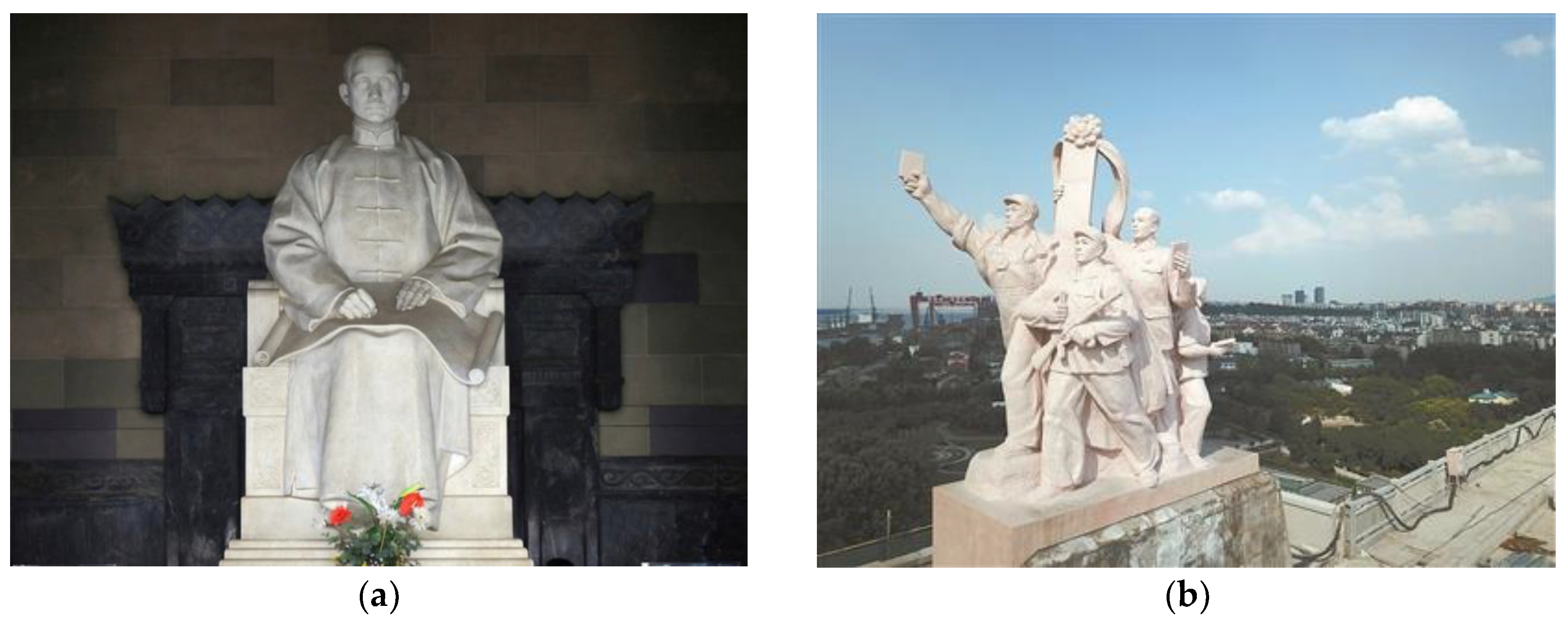
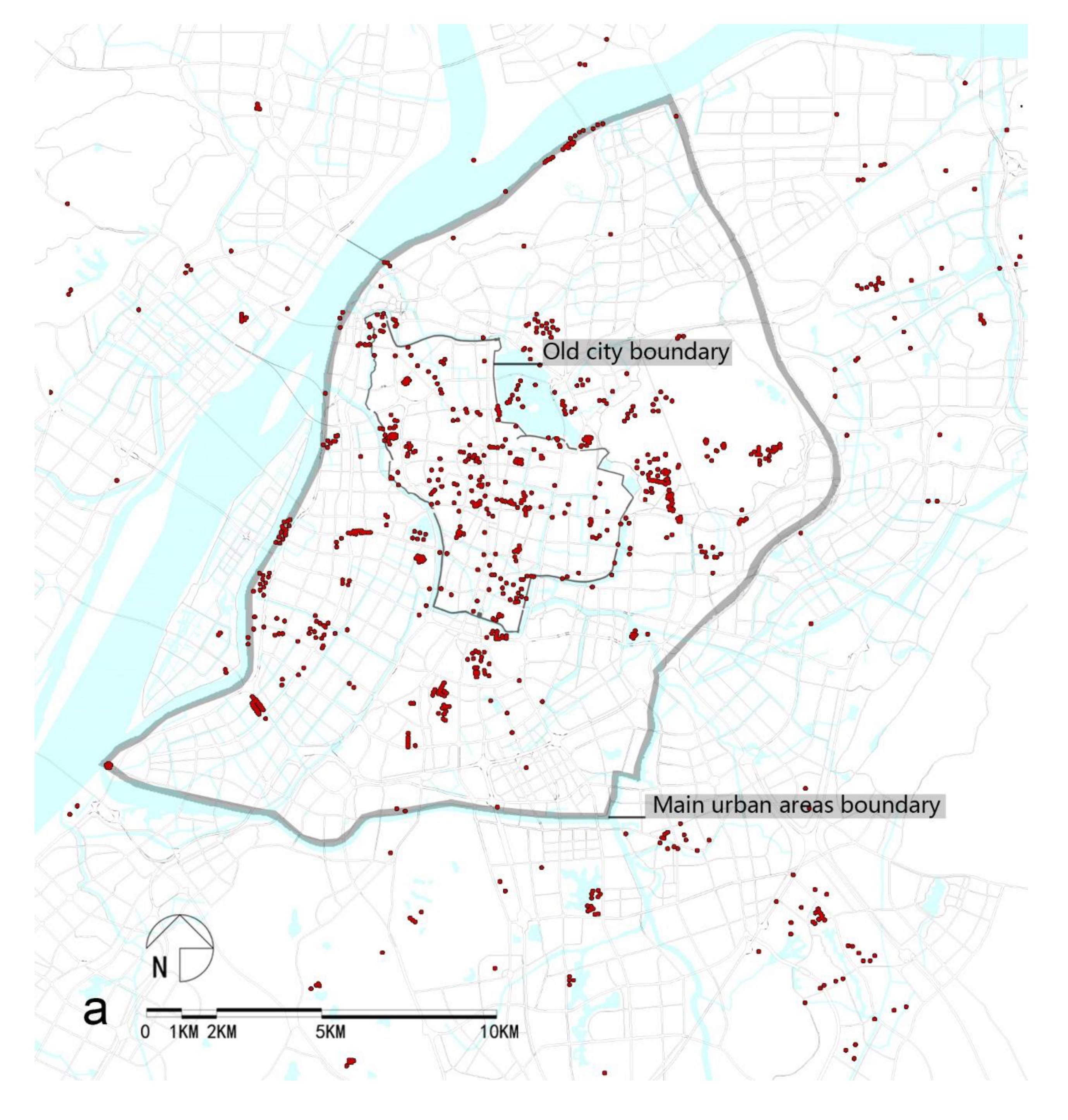
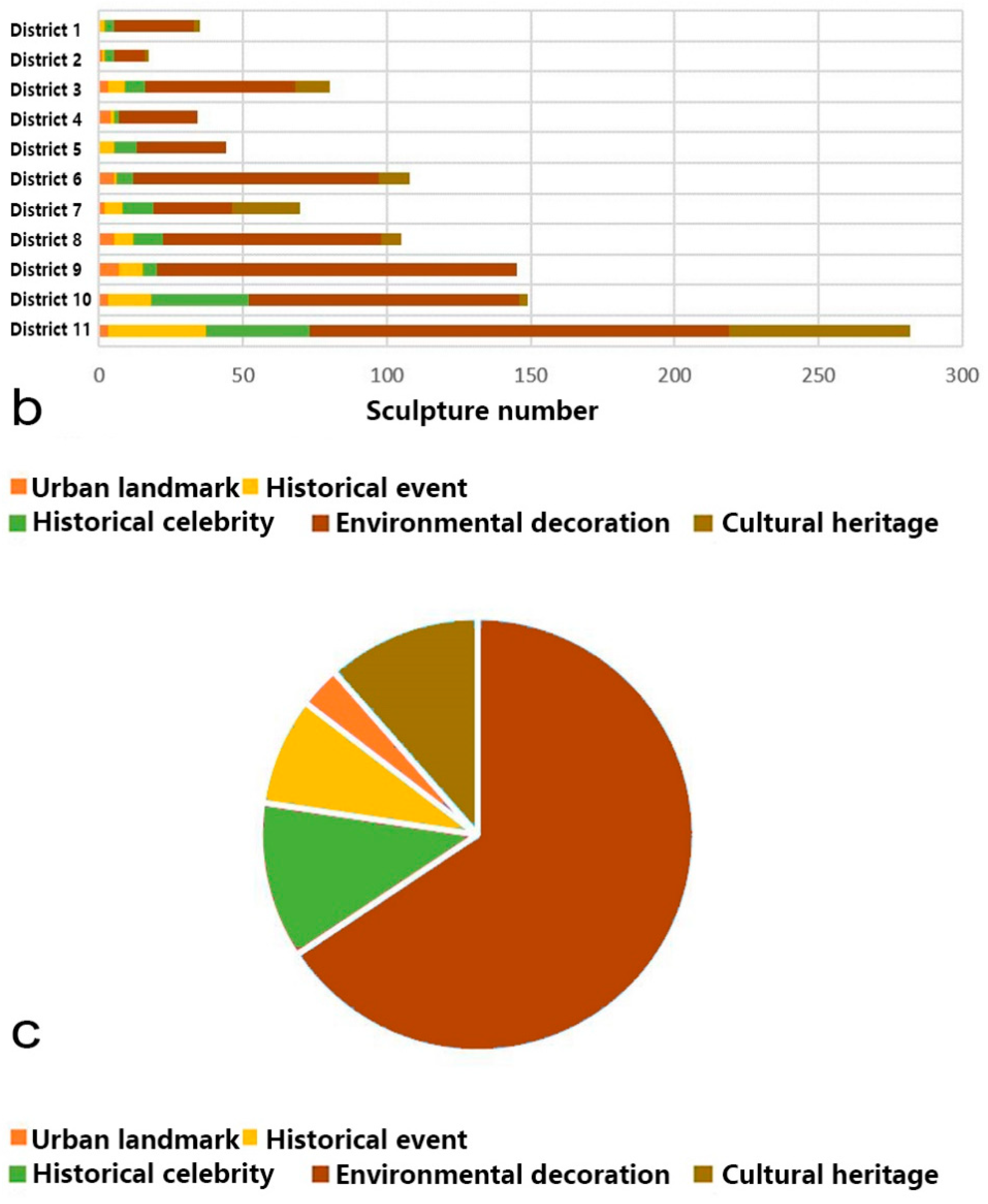
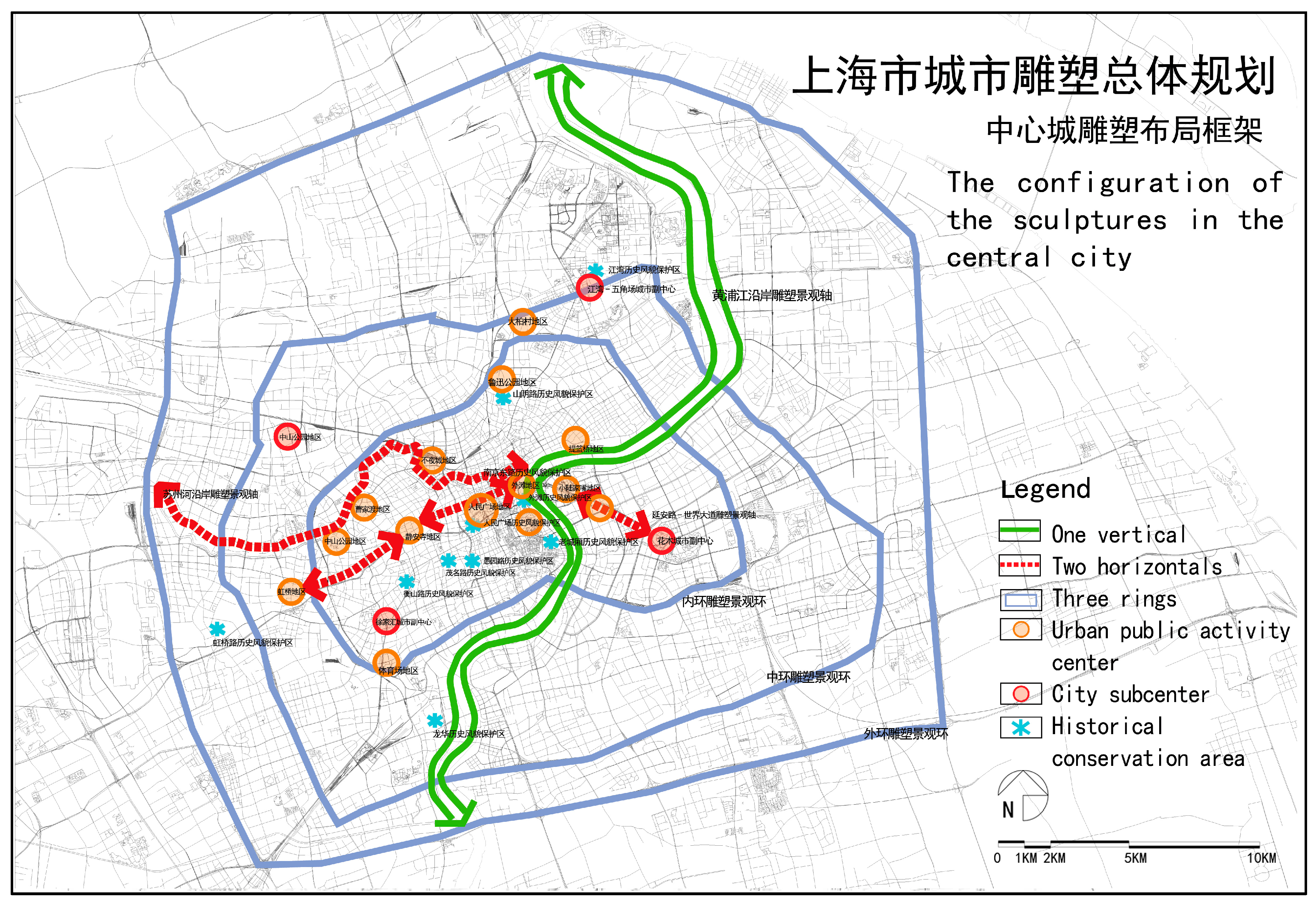
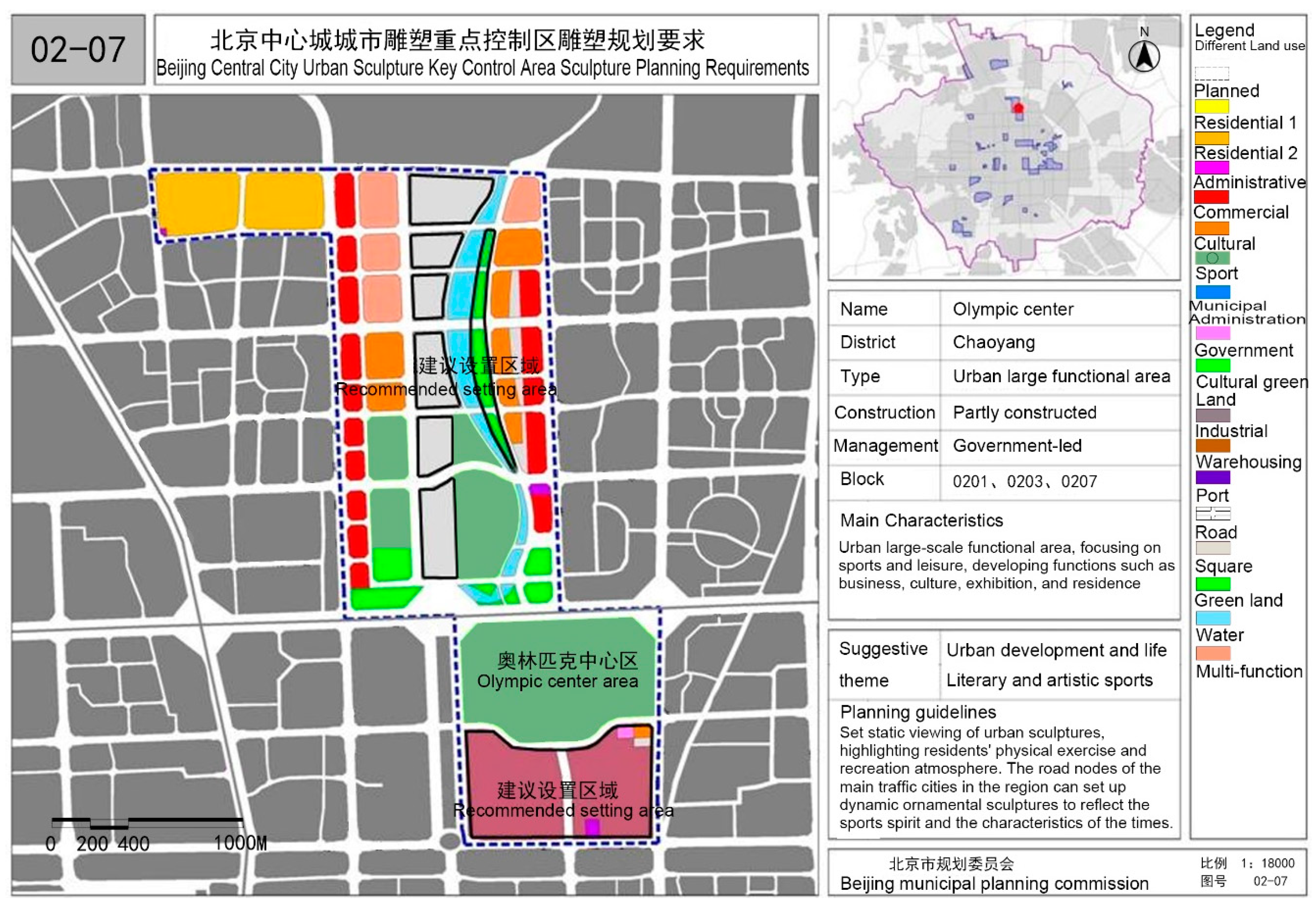
| Type of Product or Activity | |
|---|---|
| Tangible Sculpture, Painting, monument, building, multimedia, or other permanent or temporary physical work of art | Intangible Event, performance, or gathering (temporary activity); oral history or cultural expressions passed on from generation to generation |
| Search Terms |
|---|
| Q1: “urban sculpture planning*” |
| Q2: “urban sculpture” and “planning” |
| Q3: “public art planning*” |
| Q4: “public art” and “planning” |
| Aspects | Attributes |
|---|---|
| • Planning development over time | |
| Related information about the planning documents | Who, why, when, how, where (city) the plans were formulated and implemented |
| •Current situation of urban sculpture development | |
| Distribution | Overall layout of the current sculptures |
| Number of sculptures | For current situation |
| Artistic quality | The information carried by urban sculptures, such as cultural metaphor and historical connotation; the relationship between sculptures and social, historical, and physical environment; it is usually reflected in the characteristics of sculptures, such as theme, size, color, etc. |
| Physical quality | Current problems of materials, sources, or energy consumption |
| Management | Participator, financial factor, legislative condition |
| • Methodological approaches for planning | |
| Planning from different levels | Master plan, district-level plan and detailed plan |
| Overall layout of the sculpture | Distribution structure of corridor, cluster, and nodes, etc. |
| Planning bases | Related urban planning systems: Master plan, urban design, subject plan, green space system, etc. |
| Selection of sculpture characteristics | Theme, size, type, color, material, color, etc. |
| Urban space related with sculptures | Public spaces of different functions based on land use type |
| Guidance principles | Different guidelines in relation to different levels |
| Heritage and culture | How to embed cultural and historical elements in sculptures |
| Vision and goal | The goal or vision anticipated on the plans |
| Implementation strategy | Participators, such as government, leader, planner, architects, artists, citizens, etc., how to broaden the participation; Methods of public participation |
| City | Beijing | Shanghai | Chongqing | Ningbo | Wuhan | Nanjing | Shanghai | Guangzhou | Xi’an |
|---|---|---|---|---|---|---|---|---|---|
| Number | 1836 | 1034 | 700 | 235 | 500 | 1046 | 3500 | 1245 | 572 |
| Year | 2004 | 2004 | 2004 | 2010 | 2012 | 2014 | 2015 | 2015 | 2017 |
| Value in Relation to Sustainability | Factor | Attributes |
|---|---|---|
| Economic and Environmental Value | Systematism | Smart site design of the sculptures in a collaborative system; creation of urban image; overall structure of distribution as a narrative system; marketing place |
| Cultural value | Regionalism | Urban identities; local distinctiveness; cultural heritage utilization (tangible and intangible); adaptive theme and characteristics of sculptures |
| Environmental Value | Life cycle Physical-life Artistic-life | Eco-friendly materials; renewable and low carbon resources; reduction of energy consumption Harmonious relationship of sculpture and environment; improvement of the environmental quality |
| Social value | Management | Intergenerational equilibrium; people oriented; resilient system; phased arrangement |
© 2018 by the authors. Licensee MDPI, Basel, Switzerland. This article is an open access article distributed under the terms and conditions of the Creative Commons Attribution (CC BY) license (http://creativecommons.org/licenses/by/4.0/).
Share and Cite
Liu, Z.; Uyttenhove, P.; Zheng, X. Moving Urban Sculptures towards Sustainability: The Urban Sculpture Planning System in China. Sustainability 2018, 10, 4802. https://doi.org/10.3390/su10124802
Liu Z, Uyttenhove P, Zheng X. Moving Urban Sculptures towards Sustainability: The Urban Sculpture Planning System in China. Sustainability. 2018; 10(12):4802. https://doi.org/10.3390/su10124802
Chicago/Turabian StyleLiu, Zhe, Pieter Uyttenhove, and Xin Zheng. 2018. "Moving Urban Sculptures towards Sustainability: The Urban Sculpture Planning System in China" Sustainability 10, no. 12: 4802. https://doi.org/10.3390/su10124802
APA StyleLiu, Z., Uyttenhove, P., & Zheng, X. (2018). Moving Urban Sculptures towards Sustainability: The Urban Sculpture Planning System in China. Sustainability, 10(12), 4802. https://doi.org/10.3390/su10124802





